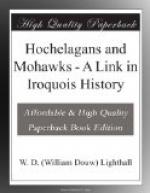We may now draw some conclusions. Originally the population of the St. Lawrence valley seems to have been occupied by Algonquins, as these people surrounded it on all sides. A question I would like to see investigated is whether any of these built villages and grew corn here, as did some of the Algonquins of the New England coast and those of Allumette Island on the Ottawa. This might explain some of the deserted Indian clearings which the early Jesuits noted along the shore of the river, and of which Champlain, in 1611, used one of about 60 acres at Place Royale, Montreal. Cartier, it is seen, expressly explains some of them to be Huron-Iroquois clearings cultivated under his own observation. The known Algonquins of the immediate region were all nomadic.
In 1534 we have, from below Stadacona (Quebec) to above Hochelaga (Montreal), and down the Richelieu River to Lake Champlain, the valley in possession of a Huron-Iroquois race, dominated by Hochelaga, a town of say 2,000 souls, judging from the Huron average and from Cartier’s details. The descendants of the Hochelagans in 1642 pointed out the spots where there were “several towns” on the island. Mr. Beauchamp holds, with Parkman, Dawson and other writers, that “those who pointed out spots in 1642 were of an Algonquin tribe, not descendants of the Mohawk Hochelagans, but locally their successors.” But I cannot accept this Algonquin theory, as their connection with the Hochelagans is too explicit and I shall give other reasons further on. The savages, it is true, called the island by an Algonquin name; “the island where there was a city or village,"[6] the Algonquin phrase for which was Minitik-Outen-Entagougiban, but these later terms have small bearing. The site of one of the towns on the island is conjectured, from the finding of relics, to have been at Longue Pointe, nine miles below Hochelaga; a village appears from Cartier’s account of his third voyage to have existed about the Lachine Rapids; and another was some miles below, probably at Point St. Charles or the Little River at Verdun. Fourteen skeletons, buried after the Mohawk fashion, have been discovered on the upper slope of Westmount, the southern ridge of Mount Royal, about a mile from Hochelaga and not far from an old Indian well, indicating possibly the proximity of another pre-historic town-site of the race, and at any rate a burying ground. The identification and excavations were made by the writer. If, however, the southern enemies, called Toudamans, five of whose scalps were shown Cartier at Stadacona were, as one conjecture has it, Tonontouans or Senecas, the Iroquois identity theory must be varied, but it is much more likely the Toudamans were the Etchemins. At any rate it seems clear that the Hochelagan race came down the St. Lawrence as a spur (probably an adventurous fishing party) from the great Huron-Iroquois centre about Lake Huron[7]; for that their advent had been recent appears from the fewness of sites discovered,




